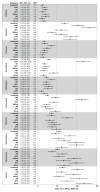Hospitalization rates among survivors of childhood cancer in the Childhood Cancer Survivor Study cohort
- PMID: 22180128
- PMCID: PMC3359936
- DOI: 10.1002/pbc.24017
Hospitalization rates among survivors of childhood cancer in the Childhood Cancer Survivor Study cohort
Abstract
Background: Chronic health conditions are common among long-term childhood cancer survivors, but hospitalization rates have not been reported. The objective of this study was to determine overall and cause-specific hospitalization rates among survivors of childhood cancer and compare rates to the U.S. population.
Procedure: The Childhood Cancer Survivor Study (CCSS) is a retrospective cohort of 5+ year survivors of childhood malignancies treated at 26 participating centers. Self-reported hospitalizations from 10,366 survivors (diagnosed 1970-1986) were compared to U.S. population rates using age- and sex-stratified standardized incidence ratios (SIRs). Reasons for hospitalization were evaluated and associations between demographic, cancer and treatment-related risk factors with hospitalization were investigated.
Results: Survivors were, on average, 20.9 years from cancer diagnosis (SD: 4.6, range: 13-32) and 28.6 years of age (SD: 7.7, range: 13-51). Survivor hospitalization rates were 1.6 times the U.S. population (95% CI: 1.6; 1.7). Increased hospitalization rates were noted irrespective of gender, age at follow-up and cancer diagnosis, with highest SIRs noted among male (SIR = 2.6, 95% CI: 2.2; 3.0) and female (SIR = 2.7, 95% CI: 2.4; 3.1) survivors aged 45-54. Female gender, an existing chronic health condition and/or a second neoplasm, and prior treatment with radiation were associated with an increased risk of non-obstetrical hospitalization.
Conclusions: Survivors of childhood cancer demonstrate substantially higher hospitalization rates. Additional research is needed to further quantify the healthcare utilization and economic impact of treatment-related complications as this population ages.
Copyright © 2011 Wiley Periodicals, Inc.
Conflict of interest statement
Figures

References
-
- Mariotto AB, Rowland JH, Yabroff KR, et al. Long-term survivors of childhood cancers in the United States. Cancer Epidemiol Biomarkers Prev. 2009 Apr;18(4):1033–1040. - PubMed
-
- Ries L, Melbert D, Krapcho M, et al. SEER Cancer Statistics Review, 1975–2004. National Cancer Institute; 2006.
-
- Oeffinger KC, Hudson MM. Long-term complications following childhood and adolescent cancer: foundations for providing risk-based health care for survivors. CA Cancer J Clin. 2004;54:208–236. - PubMed
-
- Oeffinger KC, Robison LL. Childhood cancer survivors, late effects, and a new model for understanding survivorship. JAMA. 2007;297:2762–2764. - PubMed

